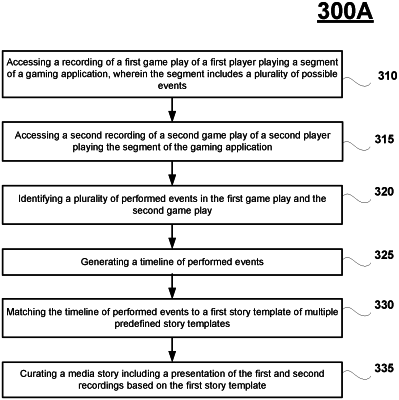| CPC A63F 13/52 (2014.09) [A63F 13/46 (2014.09); A63F 13/812 (2014.09); A63F 13/86 (2014.09); A63F 2300/577 (2013.01); A63F 2300/61 (2013.01); A63F 2300/8011 (2013.01)] | 10 Claims |

|
1. A method for dramatizing video gaming performed by a processor and memory, the memory for storing instructions for execution by the processor, comprising:
accessing a first recording of a first game play of a first player playing in single-player mode a segment of a gaming application, wherein the segment includes a plurality of possible events;
accessing a second recording of a second game play of a second player playing in the single-player mode the segment of the gaming application, wherein the first game play and the second game play are performed asynchronously;
identifying a plurality of performed events in the first game play and the second game play based on first game state data of the first game play and second game state data of the second game play, wherein the identifying includes matching the plurality of performed events in the first game play and the second game play to modeled events generated by artificial intelligence, wherein the artificial intelligence is implemented by an event classification model that receives the first game state data and the second game state data and classifies the plurality of performed events that match the modeled events occurring within a plurality of predefined story templates;
generating a timeline of performed events including each of the plurality of performed events;
matching a first timing of the plurality of performed events in the first game play and the second game play occurring in the timeline of performed events to a second timing of events included in a first story template of the plurality of predefined story templates; and
automatically creating a media story relating the first game play and the second game play that are performed asynchronously including at least portions of the first recording and the second recording corresponding to at least one of the plurality of performed events that are identified based on the first story template.
|